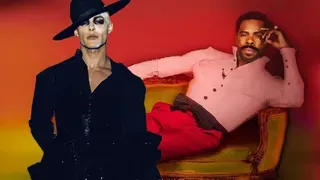September 1, 2014
What's Coming to Art Museums This Fall?
Kilian Melloy READ TIME: 4 MIN.
It's hard to believe, but the fall arts season is upon us. This year's slate is noteworthy for the absence of SFMOMA and MoAD; both are closed for renovation, and the Berkeley Art Museum follows suit on Dec. 21.
September is a banner month that heralds the arrival of a portion of the Anderson Collection, amassed by Menlo Park collectors Hunk, Moo and Putter Anderson. Their gift of 121 post-war modern, abstract expressionist artworks to Stanford University is housed in a newly constructed, 33,000 sq. ft. building that opens to the public on Sept. 21.
Also making news is Ai Weiwei, the fearlessly outspoken political activist/artist who's controversial both abroad and in his native China, where he has served time in jail. So there's symmetry in that his latest site-specific installation, wryly titled "@Large," will be at the escape-proof former prison on Alcatraz. Given that the artist is not allowed to leave China, it will prove interesting to see how he pulls this gambit off when the project opens on Sept. 27.
The Asian Art Museum's big fall show, "Roads of Arabia: Archaeology and History of the Kingdom of Saudi Arabia," explores the heritage of the peninsula, a cultural crossroads for trade and migration whose mysterious ancient past reaches back a million years. Gold funerary objects from a royal tomb unearthed 2,000 years ago, gilded doors from a holy Islamic sanctuary, stone steles and tools, monumental statuary, Hellenistic bronzes and other recent discoveries are among the treasures in this traveling exhibition. (Oct. 24-Jan. 18)
The Contemporary Jewish Museum's "Arnold Newman: Masterclass" includes 200 vintage black & white photographic portraits of famous subjects such as Marilyn Monroe, Pablo Picasso, Marc Chagall, Salvador Dali, Max Ernst, Martha Graham, Grandma Moses and JFK, as well as street photography, architectural studies, still-lifes and worksheets by the prolific Newman, an influential 20th-century photographer known for incorporating the habitats of the accomplished, powerful and creative figures he photographed. (Oct. 23.-Feb. 1) Marking the 20th anniversary of the beloved "Mr. Lunch" books, "J. Otto Seibold and Mr. Lunch" explores their history and that of Seibold, an innovative children's book illustrator and East Bay resident. (Nov. 20-Mar. 8)
"Robert Frank in America," an insightful retrospective at the Cantor Arts Center, consists primarily of unknown photographs from Frank's early career, before he turned to filmmaking. Mostly drawn from the museum's collection, they pinpoint the profoundly influential Swiss photographer's pictorial themes and strategies, and illuminate his extensive work from the 1950s, his observations of the U.S. while on the road traversing the country, and the making of his landmark 1959 book, "The Americans." (Sept. 10-Jan. 5)
If you can't get enough of Downton Abbey, "Houghton Hall: Portrait of an English Country House" at the Legion of Honor may be the show for you. The exhibition, a microcosm of how the 100th of 1% spent their leisure time, stars Houghton Hall in Norfolk. Built in the too-rich-for-you Palladian style in the 1720s by England's first Prime Minister, it's considered one of the premiere English country manses. With furnishings, silver, porcelain, English paintings and objects owned by the hereditary Lord Great Chamberlain. (Oct. 18-Jan. 18)
At the de Young Museum, "Keith Haring: The Political Line," the first West Coast exhibition of the New York artist's work in 20 years, utilizes a political filter to assess and organize 130 large-scale paintings, sculptures and a selection of subway drawings by Haring, who dedicated himself to social justice causes from nuclear disarmament, racial prejudice and economic inequality to the environment. Haring, whose public art projects have graced city venues, and whose career reached its apex in the 1980s, spoke eloquently as an individual and through his art about the fight to eradicate AIDS and his own illness, which took his life in 1990. (Nov. 8-Feb. 16)
Oakland Museum of California's "Fertile Ground: Art and Community" in California, yet another partnership with the temporarily gone-but-not-forgotten SFMOMA, examines how artists in the Golden State have influenced and been informed by trends, cultures and the greater art-world. It focuses on four pivotal periods, and clusters of artists, beginning in the 1930s with muralists like Diego Rivera, moving through the Bay Area Figurative Gang and the Mission School to the present. Frida Kahlo, David Park, Ansel Adams, Edward Weston, Dorothea Lange, Barry McGee, Wayne Thiebaud, Manuel Neri, Mark Rothko and Chris Johanson are just a few of those featured. (Sept. 20-April 12)
"Momentum: an experiment in the unexpected:" For its 45th anniversary, the San Jose Museum of Art invited a group of artists from multiple disciplines to "intervene" or otherwise respond to works in the permanent collection by Calder, Tony Oursler, Jim Campbell, Deborah Oropallo and others. A calligrapher, a standup comedian, an industrial designer, a musician, a body painter and a yarn bomber - that's someone who knits and crochets over public property such as poles, trees and sidewalks - are among the "disruptors." But alas, no art critics were invited. (Oct. 2-Feb. 22)
Kilian Melloy serves as EDGE Media Network's Associate Arts Editor and Staff Contributor. His professional memberships include the National Lesbian & Gay Journalists Association, the Boston Online Film Critics Association, The Gay and Lesbian Entertainment Critics Association, and the Boston Theater Critics Association's Elliot Norton Awards Committee.






